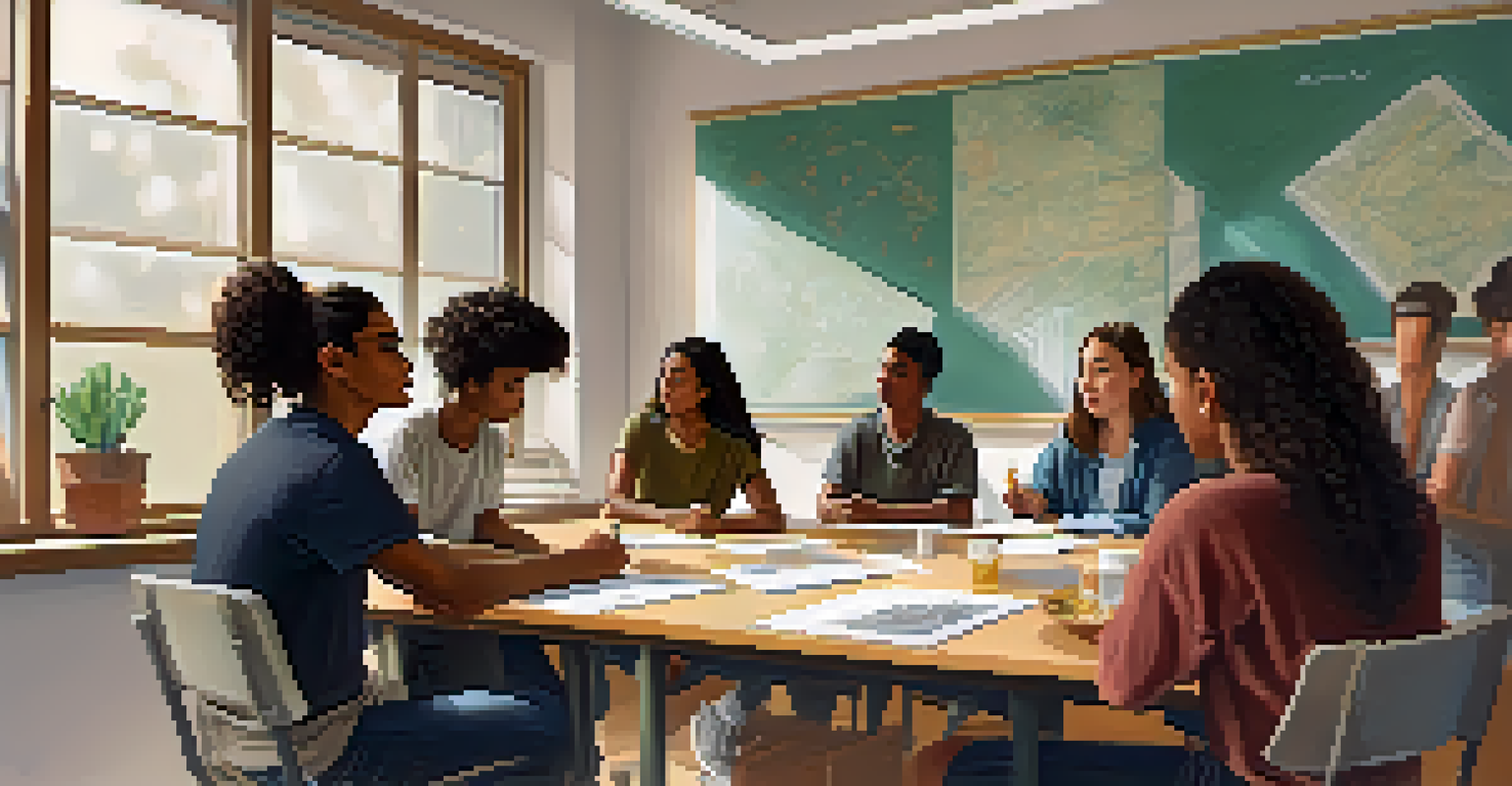Mindfulness Practices to Enhance Student Collaboration

Understanding Mindfulness in Education Settings
Mindfulness is the practice of being present in the moment, which can greatly enhance the learning experience. For students, being mindful means focusing on their thoughts and feelings without judgment, enabling them to engage more fully with their peers. In educational settings, this practice not only aids personal development but also improves group dynamics, fostering a collaborative spirit.
Mindfulness isn't difficult. What's difficult is to remember to be mindful.
When students practice mindfulness, they become more aware of their emotions and reactions, leading to better communication. This awareness can help reduce conflicts and misunderstandings, making collaboration smoother and more enjoyable. By incorporating mindfulness into the classroom, educators can create an environment that encourages teamwork and mutual respect.
Moreover, mindfulness helps students develop empathy towards their classmates. This understanding is crucial for effective collaboration, as it enables students to appreciate diverse perspectives and work together harmoniously. Ultimately, the integration of mindfulness in education nurtures not just individual growth, but collective success.
Simple Mindfulness Techniques to Start With
One effective mindfulness technique is mindful breathing. This involves taking a few moments to focus solely on one's breath, which can help clear the mind and prepare for group activities. By introducing this practice before collaborative tasks, students can center themselves, leading to more productive interactions.

Another technique is the body scan, where students pay attention to different parts of their bodies, noticing any tension or discomfort. This practice encourages relaxation and self-awareness, allowing students to better engage with their peers. When students are relaxed, they are more likely to contribute positively to group dynamics.
Mindfulness Enhances Collaboration
Practicing mindfulness helps students become more aware of their emotions and reactions, leading to better communication and teamwork.
Finally, practicing gratitude can enhance collaboration. Encouraging students to express appreciation for their classmates fosters a positive atmosphere. This simple act can significantly improve relationships, making teamwork more enjoyable and effective.
Creating a Mindful Classroom Environment
To effectively implement mindfulness practices, creating a supportive classroom environment is essential. This can be achieved by setting aside time for mindfulness exercises during the day, allowing students to unwind and refocus. Simple adjustments, like soft lighting or calming music, can also help cultivate a serene atmosphere conducive to mindfulness.
The greatest weapon against stress is our ability to choose one thought over another.
Incorporating visuals, such as motivational quotes or calming images, can further enhance the mindfulness experience. These elements serve as gentle reminders for students to remain present and engaged. A well-designed environment not only promotes mindfulness but also encourages collaboration among students.
Lastly, educators should model mindfulness themselves. By demonstrating mindfulness practices, teachers can inspire students to adopt these techniques. When students see their teachers practicing what they preach, they are more likely to embrace mindfulness as part of their collaborative efforts.
Mindfulness and Active Listening Skills
Active listening is a crucial component of effective collaboration, and mindfulness can significantly enhance this skill. When students practice mindfulness, they learn to focus fully on the speaker without distractions. This attentiveness fosters a deeper understanding of their peers' perspectives, leading to more meaningful discussions.
Furthermore, active listening encourages empathy, as students become more attuned to the emotions and needs of their classmates. This empathetic approach not only strengthens relationships but also promotes a culture of collaboration. As students learn to listen more effectively, they can contribute their ideas more thoughtfully and respectfully.
Techniques for Mindful Engagement
Simple mindfulness techniques, such as mindful breathing and gratitude, can significantly improve group dynamics and positive interactions.
To nurture active listening, educators can incorporate mindfulness exercises that focus on presence and attention. By practicing these skills regularly, students will find it easier to engage in collaborative activities, creating an environment where everyone feels heard and valued.
Using Mindfulness to Resolve Conflicts
Conflict is a natural part of collaboration, but mindfulness can provide tools for resolution. When students are trained to respond mindfully to disagreements, they are less likely to react impulsively. Instead, they learn to pause, reflect, and approach conflicts with a calm mindset, which can lead to effective solutions.
Mindfulness encourages students to take ownership of their emotions and recognize the impact they have on group dynamics. By understanding their feelings, students can communicate their concerns more clearly and constructively. This self-awareness can help prevent misunderstandings that often escalate into conflicts.
Moreover, teaching students mindfulness techniques, such as visualization or compassionate communication, equips them with strategies to navigate conflicts. These tools encourage collaboration and problem-solving, turning potential conflicts into opportunities for growth and understanding.
Integrating Mindfulness into Group Projects
Group projects can be both exciting and challenging, but incorporating mindfulness can enhance the experience. By beginning group work with a short mindfulness exercise, students can establish a sense of unity and focus. This shared practice sets a positive tone for collaboration and helps everyone align their goals.
Additionally, assigning roles based on mindfulness principles can promote accountability within the group. For example, designating a 'mindfulness leader' encourages one student to guide mindfulness practices during sessions. This role not only fosters leadership skills but also reinforces the importance of mindfulness in teamwork.
Creating a Mindful Classroom
Establishing a supportive environment and modeling mindfulness practices can foster a culture of collaboration and respect among students.
Finally, reflecting on the group's dynamics through mindfulness can help students assess their collaboration. After completing a project, students can engage in a mindfulness discussion, sharing their experiences and feelings. This reflection reinforces learning and encourages continuous improvement in future collaborations.
Evaluating the Impact of Mindfulness on Collaboration
To truly understand the benefits of mindfulness in student collaboration, it's essential to evaluate its impact regularly. Educators can use surveys or reflective journals to gather feedback from students about their experiences. This information can provide valuable insights into how mindfulness practices influence group dynamics and overall satisfaction.
Additionally, observing group interactions can help educators identify changes in communication and collaboration styles. Noticing improvements in teamwork, conflict resolution, and active listening can highlight the positive effects of mindfulness. Such observations can also inform future mindfulness initiatives in the classroom.

Ultimately, evaluating the impact of mindfulness enables educators to refine their approaches and support student collaboration effectively. By continually assessing and adjusting practices, teachers can ensure that mindfulness remains a valuable tool for fostering teamwork and enhancing the learning experience.